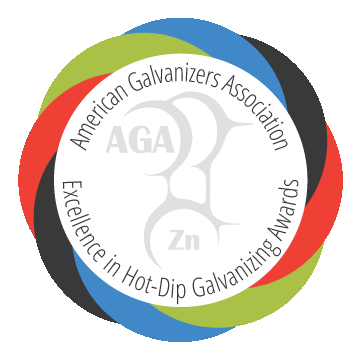Blough Avenue Bridge
Navarre, OH United States | 1998
 1998
1998
Menu • Quick Links • Search
This Y-bridge in Zanesville, OH, is an unusual and historic bridge. It spans two rivers, the Muskingum and the Licking Rivers. To do so, it was designed as its famous Y shape. It is also located on historic Route 40, which was one of the early road systems developed for westward travel coming from the east coast. This project involved refurbishment of existing bridge structures and old stone abutments and replacement of the bridge deck, railings, and new construction for the lift span over the canal. Much of the design was in keeping with the nostalgic appearance of older bridges.
Galvanizing was the logical choice of corrosion protection...
The galvanized steel was painted to blend with the overall visual theme desired and also to match existing steel on the main part of the bridge. Aesthetics were also important due to the historic value of the bridge, as well as its proximity to downtown Zanesville. The ODOT bridge design and specifications continued emphasizing aesthetic features such as stone texture, decorative railings, and lighting.
The Ohio DOT had seen the cost savings and performance benefits of other galvanized steel bridges, particularly short span bridges. The decorative railing was galvanized and painted, keeping the same basic style and appearance as a previous bridge project, also over the Muskingum River.
All the steel was prepared for painting after the galvanizing process. The large plate girders were designed so they could be progressively dipped, providing a smoother and cleaner finished coating. Railings and posts were designed from heavy sections of structural steel tube, pipe, channel, and flat bar. Ornamental post caps were designed for installation after galvanizing. This allowed for better processing of the posts in the galvanizing operation and also provided a good-looking and well-fitting post cap. Leaving the post top open provided for an exceptionally smooth, uniform zinc coating, which was important for the painting requirement and eliminated much clean-up from zinc drainage. More than 140 tons of steel were galvanized for this project.
The bridge railings will be subjected to the effects of winter de-icing salts and normal abrasive road debris such as small stones. Although the top coat of paint may experience some chipping in time, the underlying zinc coating from galvanizing will provide a durable, abrasion resistant coating to the base steel. Protection of the structure is important, as the railing is designed not only for the safety of pedestrians crossing the bridge, but also for motorists.
Galvanizing was the logical choice of corrosion protection for the bridge, which reaches over the canal bed, because of its maintenance-free nature. Two high stone end walls make this bridge very difficult to access, so future maintenance costs and difficulty will be minimized with the protection of galvanized steel. The bridge steel developed a typical coating thickness of 8 to 15 mil, while the railings and posts had a thickness of 4 to 8 mils. With its history of proven performance, the galvanized steel used in this job will benefit the life span of this historic bridge.
Newly Complete
Bridge & Highway
Select Environment
Zanesville, OH United States
Aesthetics, Coating Durability, Corrosion Performance, Ease of Specifying, Prior HDG Experience, Quality of HDG
Bridge steel for the lift span. Rolled beams and plate girders for the fascia girders. Floor beams, channel diaphragms, sidewalk stringers, expansion joints. Bridge railing.
Steel: 145
HDG: 145
Ohio DOT District 3
High Steel Structures Inc., Burghardt Manufacturing
Ohio Department of Transportation
Richland Engineering Limited
Gregory Galvanizing and Metal Processing
Thank you! Your vote has been accepted.